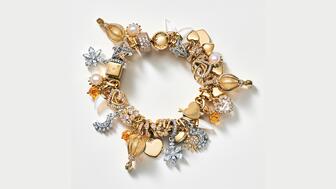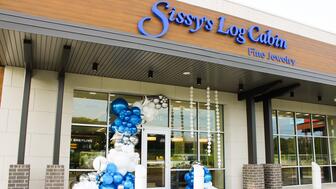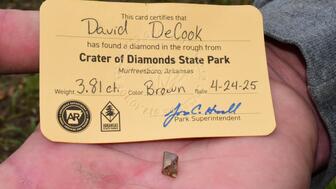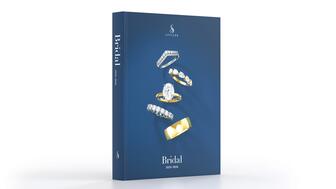Michel Desalles allegedly murdered Omid Gholian inside World of Gold N Diamond using zip ties and then fled the country.
The history behind … acrostic jewelry
This month, National Jeweler takes a look at the background of acrostic jewelry, which contained a message spelled out by the first letter of every gemstone in the piece.

New York--Antique acrostic jewelry is yet another indication that all trends really do just keep cycling in and out of fashion.
Developed as a way to relay terms of endearment and important dates and names using the first letter of each gemstone contained within the piece, acrostic jewelry was popular became of its personal sentiment. The most common were the rings that used gems to spell out the words “regard,” “dearest,” and “adore,” among others.
Now, as the personalization trend comes back into style, acrostic jewelry is returning to popularity among antique connoisseurs.
“This is the neat thing about acrostic jewelry--that it can have so much symbolism and meaning to you in terms of using the stones to represent secret messages,” said Susan Cohen of curated antique and vintage jewelry collection Circa 1700.
In this month’s The History Behind, National Jeweler discusses acrostic jewelry with Cohen and Elizabeth Doyle of Doyle & Doyle, a vintage and antique jewelry store in New York.
What is acrostic jewelry? These pieces used the first letter of each gemstone to convey secret messages or personal terms of endearment. For example, the popular “regard” rings featured a ruby, emerald, garnet, amethyst, another ruby, and a diamond. But by the time they were winding down in popularity, everybody knew what they meant and how to decipher the messages.
“Adore” and “Regard” were among two of the most popular phrases spelled out with stones, but people also used dates or spelled out their own messages that were more personal, some of which might’ve taken longer to decipher. It was very clear in most of those cases that it was an acrostic piece because of the sometimes odd combination of stones.
When was it popular? The pieces started showing up during the Georgian period and increased in popularity through the Victorian era (1837 to 1901, spanning the 64-year reign of Queen Victoria.) It is believed acrostic jewelry really got its start with designer Jean-Baptiste Mellerio of the House of Mellerio, a favorite of Marie Antoinette. He started with a ring using gems that spelled “J ’adore,” which is “I love” in French. Napoleon Bonaparte even had some very famous acrostic pieces that commemorated events.
“He had several pieces made for himself, for Joséphine (his first wife), and for his second wife. He had pieces made, especially bracelets, with names, dates and births on them,
Were they limited to specific types of stones or messages? Generally it was specific stones for each letter, but they could use them to make the jewelry say anything they wanted to, Cohen and Doyle noted.
In addition, some of the stones had different names at the time. For example, hessonite garnet used to be called vermeil (which now refers to gold-plated silver) and they would use it to spell out “love.”
The materials used also depended on what people were having commissioned. Once stacking acrostic rings became popular, they could play around with those in terms of using different stones to represent different information for people, and they would also do acrostic bracelets and brooches, which gave them more room to relay a message.
“I’ve seen a regard ring actually with six different bands,” Cohen said. “With the bracelets, that obviously gave them more room to be played with and they would have a lot more space. And then you could stack the rings. You could have different rings mean different messages or you could have the stones going all the way across the band as well.”
Are people buying these rings today? While they’re certainly not as popular and well-known now as they were then, people are buying acrostic pieces again. This jewelry is having a resurgence right now, especially amongst the crowd that already has an idea of what they are, Cohen and Doyle said.
The pieces that are in good shape with quality stones are especially popular. But they’re also hard to find, especially when they have unique designs. They’re similar to the trends popping up again right now of people wanting to be able to personalize and customize everything, and to have a piece with a history behind it adds more value.
Some jewelers today are even making modern versions, like the Lulu Frost brand, which calls them “code” instead of acrostic but means the same thing.
What are acrostic rings worth today? They tend to vary in price, depending on factors include the stones, age of the piece and size.
The simpler ones, like the “regard” rings, are among the easiest to find because there were a more made and many have survived. Those can be found for about $1,000, Doyle said.
Sometimes the gems are arranged in patterns, such as in a flower shape, and a more complicated design makes it more expensive, especially when it has a historical provenance. So, depending on the design, message, rarity and especially the date, acrostic pieces can cost as much as $3,000 to $5,000, Cohen said.
If a retailer wanted to add acrostic jewelry to their offerings, how would they do that? There are dealers who specialize in acrostic jewelry, and someone who carries Georgian or Victorian jewelry might have it.
Finding a dealer in the United Kingdom would probably be a good place to start because a lot of that jewelry has remained there and that seems to be the “hub” for a lot of those special pieces, Cohen said.
Doyle also noted, “The problem is there’s always a lot of fakes out there, so you have to be careful about that. You have to go with somebody who’s reputable and really knows what it is.”
The Latest

Associate Editor Lauren McLemore shares her favorite looks from a night of style inspired by Black dandyism.


Sponsored by Instappraise

Gain access to the most exclusive and coveted antique pieces from trusted dealers during Las Vegas Jewelry Week.

CEO Beth Gerstein discussed the company’s bridal bestsellers, the potential impact of tariffs, and the rising price of gold.


The brand’s first independent location outside of Australia has opened in Beverly Hills, California.

Cathy Marsh will lead the jewelry company’s efforts in the upper Midwest and western United States.

Supplier Spotlight Sponsored by GIA

The company has multiple strategies for dealing with tariffs, though its CEO said moving manufacturing to the U.S. is not one of them.

Connecting with your customers throughout the year is key to a successful holiday marketing push.

Its commercial-quality emerald sale held last month totaled more than $16 million, up from about $11 million in September 2024.

National Jeweler Editor-in-Chief Michelle Graff joined Michael Burpoe to talk tariffs, consumer confidence, and the sky-high price of gold.

Designer Lauren Harwell Godfrey made the piece as an homage to the 2025 gala’s theme, “Superfine: Tailoring Black Style.”

Expanded this year to include suppliers, JA’s 2025 list honors 40 up-and-coming professionals in the jewelry industry.

Located in Fort Smith, it’s the Mid-South jeweler’s first store in Northwest Arkansas.

The episode about the family-owned jeweler will premiere May 17.

The Houston-based jeweler’s new 11,000-square-foot showroom will include a Rolex boutique.

The turquoise and diamond tiara hasn’t been on the market since it was purchased by Lord Astor in 1930.

“The Duke Diamond” is the largest diamond registered at the Arkansas park so far this year.

Set with May’s birthstone and featuring an earthworm, this ring is a perfect celebration of spring.

“Bridal 2025–2026” includes popular styles and a dedicated section for quick pricing references of lab-grown diamond bridal jewelry.

Though currently paused, high tariffs threaten many countries where gemstones are mined. Dealers are taking measures now to prepare.

Located in Miami’s Design District, the 4,000-square-foot store is an homage to David and Sybil Yurman’s artistic roots.

The deadline to apply for the Seymour & Evelyn Holtzman Bench Scholarship is June 12.

What’s really worrying U.S. consumers isn’t the present situation; it’s what the economy is going to look like six months from now.

Now called The Instore Jewelry Show, it will include holiday-focused education, interactive workshops, and a window display contest.

It includes pricing for unenhanced Colombian emeralds in the fine to extra fine range.




























